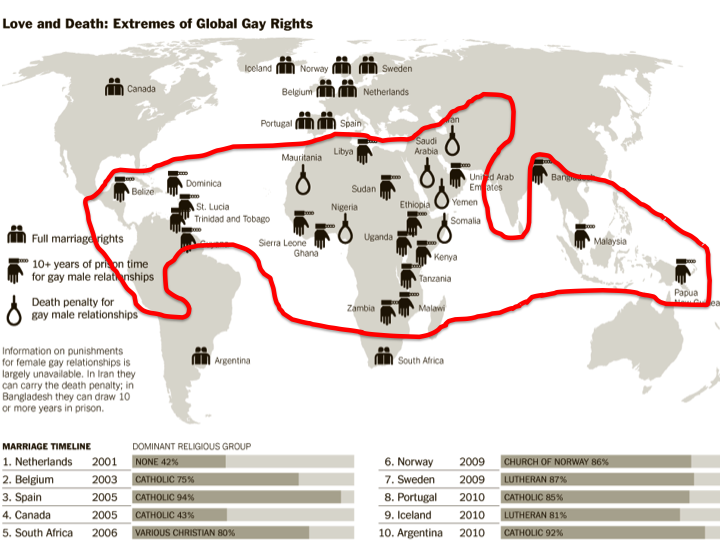Chart of the Day: Being Gay in Core v. Gap
 Tuesday, November 29, 2011 at 10:23AM
Tuesday, November 29, 2011 at 10:23AM 
NYT story from October about new gay rights in Portugal.
Map caught my eye for obvious reasons. Quick crude overlay of Core-Gap divide shows you want to be gay in the Core - not the Gap.
Not true in every single instance, but as a rule . . ..
Wherever you still are cranking babies as a means of survival, you will look down on gays. Almost all of your survival rules - like religion - will tell you to do so. But once industrialization and connectivity kick in, then you start to value them for the diversity they bring - especially in key globalized industries (yes, gays tend to concentrate somewhat in certain industries, but so do heterosexual men and women, so there!).
But the more basic point: when you connect you have to go with the acceptance of others, because you value the ties and the business more than your precious identity. Plus, you probably also see more of the world and get over yourself.










Reader Comments (3)
Just need to point this out.
Although, South Africa enshrines gay rights in its constitution, you are much more likely to be raped for being a lesbian or assaulted on the street for being a homosexual on the streets of Johannesburg, than on the streets of Dakar.
The simple Core-Gap generalisations do not work here, there are three factors at play (1) the influence of the British penal code (2) the influence of Islam and (3) the influence of Evangelical Christianity.
For example, in Nigeria the anti-homosexual laws are a legacy of the British penal code and gays can be stoned to death under Sharia law (the death penalty characterisation for Nigeria is partially correct, since most Nigerian gays don't live under Sharia law).
Secondly neither Malaysia nor Turkey freely encourage gay rights and both nations have rapidly growing economies. The rich nations of the GCC are not likely to be gay friendly in our lifetimes, no matter how much economic progress they make.
The French were more tolerant and more accepting of gays, this is why nations with a French colonial heritage tend to be more forward looking on that issue that ex-British colonies.
India has many of the characteristics of the so-called "Gap" and merely using a recent Supreme Court ruling as evidence of the "gay-friendliness" of India is extremely misleading.
Very interesting. I read the causality between connection and gay rights a little differently; my take is here:
http://www.futureatlas.com/blog/index.php/2011/11/29/values-attitudes-toward-gay-rights/
Actually, Josh, I don't see any difference in your analysis, because I agree in your additional points.
If you see Part 7 of the brief at left (YouTube), you'll see I make essentially the same arguments on wealth creation opening up tolerance. In this post, I am guilty of jumping to the happy conclusion that, once you move up the production chain, the diversity quotient necessarily rises with creativity and inventiveness.